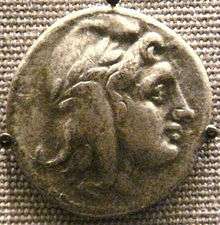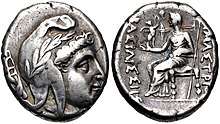Amastrine
Amastris (Greek: Ἄμαστρις; killed c. 284 BC) also called Amastrine, was a Persian princess, and ruler of the city of Heraclea from circa 300 to her death. She was the daughter of Oxyathres, the brother of the Persian King Darius III.[Note 1]
Amastris | |
|---|---|
 Didrachm of Amastris. Amastris was the first woman to issue coins in her own name. British Museum. | |
| Born | |
| Died | c. 284 BC |
| Spouse(s) | Craterus Dionysius Lysimachus |
| Children | Clearchus II and Oxyathres |
| Parent(s) |
|
Life
Amastris was given by Alexander the Great in marriage to Craterus,[Note 1] however Craterus later decided to marry Phila, one of the daughters of Antipater. Still, he first arranged his wife's advantageous marriage to Dionysius, tyrant of Heraclea Pontica[1], in Bithynia, whom she married in 322 BC. She had two sons with him named: Clearchus II and Oxyathres.[2]

After the death of Dionysius, in 306, Amastris became guardian of their children. Several others joined in this administration.[3] Amastris married Lysimachus in 302. However, he abandoned her shortly afterwards and married Arsinoe II, one of the daughters of Ptolemy I Soter, the first Pharaoh of Ptolemaic Egypt.
After her marriage to Lysimachus ended, Amastris retired to Heraclea, which she governed in her own right. She also founded shortly after 300 a city called after her own name Amastris, on the sea-coast of Paphlagonia, by the fusion (synoecism) of the four smaller towns of Sesamus, Cromna, Cytorus and Tium. Tium later regained its autonomy, but the other three remained part of the city of Amastris' territory.
She was drowned by her two sons about 284[Note 2] but the matricide was avenged by Lysimachus, who made himself master of Heraclea, and put both Clearchus and Oxyathres to death.[Note 3]
Notes
References
- Harders, Ann-Cathrin (2016). "Seleukos Nikator and His Wives". In Coskun, Altay; McAuley, Alex (eds.). Seleukid Royal Women. Historia - Einzelschriften 240. Franz Steiner Verlag. pp. 25–38. ISBN 9783515112956.
- Chris Bennett, "Three Notes on Arsinoe"; in: A Delta Man in Yebu, edited by A. K. Eyma
- James Ussher, The Annals of the World, New Leaf Publishing Group, 2007 [1654], p 338
- Smith, William; Dictionary of Greek and Roman Biography and Mythology, "Amastris (3)", Boston, (1867)

- Cohen, Getzel M.; The Hellenistic Settlements in Europe, the Islands, Asia Minor, "Amastris", (1996)
- Ptolemaic Genealogy: Ptolemy Ceraunus
- Ptolemaic Genealogy: Unknown wife of Ptolemy Ceraunus